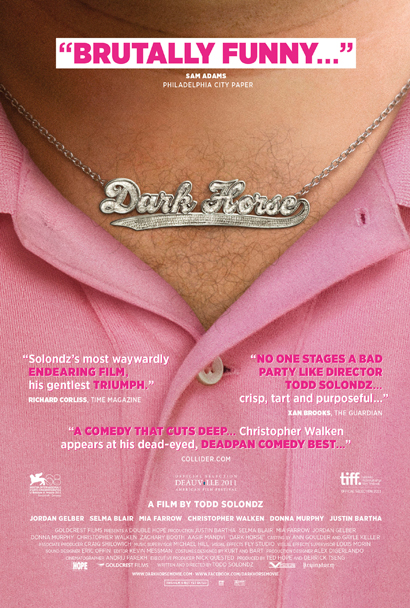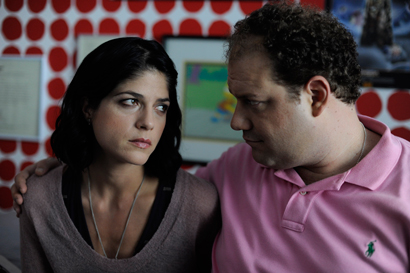By Orly Ravid
Quick tell your investors! Indie Film is safe again. The big waterfall of profits is starting to mount. Haven't you heard the news? VOD is making it all good again. Simple as making a good film that people know of and want to pay for. Seriously though, the news has been coming in and now we are getting numbers about how films perform here. And they look pretty sweet…
The Film Collaborative's Orly Ravid fortunately wants us to know even more and has done some research on the prospects of EU Digi Distro. And now I am smiling. You will be too.
New World Distribution in the Old World
As DVD sales continue to crumble (allowing us to use less petroleum), VOD is growing (now in 65.7 million US homes — about 55.7% of TV homes, according to MagnaGlobal). Digital distribution revenues are starting to percolate and be more reliable. Worldwide revenue from video-on-demand movies and TV programs will reach $5.7 billion in 2016, up 58% from revenue of $3.6 billion in 2010, according to a new research report. The tally does not include pay-per-view sports events, adult entertainment or subscription-based VOD services such as Netflix, Amazon Prime and Google, among others, according to London-based Direct TV Research Ltd. It should be noted this is not all related to new film but rather making catalog or library content available digitally. According to the study, “Internet-based TV (IPTV) is projected to overtake digital terrestrial TV (DTT) in revenue nextyear to become the third largest platform globally. Indeed, VOD revenue from DTT is expected to be largely confined to Western Europe” (source.)
In South Korea of course we know almost all have Broadband and watch films digitally but the US digital distribution market has been slower to mature, though it is finally, and so how is new world distribution faring in the old world? I wanted to explore the digital distribution trends in Europe. “The EU records the second highest TV viewing figures globally, produces more films than any other region in the world, and is home to more than five hundred online video-on-demand services” (European Commission “Green Paper” on the online distribution of audiovisual works in the European Union, 7/13/11). It should be noted that this 500 number is more theoretical and that probably only 100 are worth talking about and half of those being the main revenue generators. The EU funds new platforms but not all of them emerge successfully, much like our US government’s funding of alternative energy. “A range of platforms offering transactional on-demand services span multiple territories e.g. E.g. Acetrax, Chello, Headweb, iTunes, Playstation Network Live, Voddler, Xbox Live. These tend to continue the practice of addressing customers "in their own language", and tailoring content to local preferences such as language, film classification, dubbing or subtitling requirements, advertising, holiday periods, and general consumer tastes. This is consistent with the experience of producers and distributors whether large or small scale, who have indicated that although they license content on a multi-territorial basis where there is a business case to do so, targeted and local investments in distribution and marketing are nevertheless required in order to promote and sell films in each country” (IBID). (To read the paper in its entirety go here.)
On a side note: many European countries are used to having films dubbed not subtitled and there is apparently a new software that facilitates dubbing in the same voice as the actor / speaker. I’m looking into it further. In any case, subtitling for digital is getting less and less expensive and can be done via software or labs. If one has played a film at a film festival in another country and then plan to distribute the film there I recommend you ask the fest for access to the subtitles (if cleared for other distribution). Traditionally, Nordic, Benelux, and some others are fine with and prefer subtitles, while others (such as Germany, Spain, and Italy) require dubbing. In the higher educated arthouse/filmfest world, one can often get away with just subtitled versions even in the dubbing countries.
At The Film Collaborative we have noticed that iTunes has just recently expanded its footprint into Europe and is now available in the following EU countries: Austria, Bulgaria, Cyprus, Czech Republic, Denmark, Estonia, Finland, Greece, Hungary, Latvia, Lithuania, Malta, Netherlands, Norway, Poland, Republic of Ireland, Romania, Slovakia, Slovenia, Spain, Sweden, United Kingdom. Non-English stores include: Spain, France, Germany, Italy, Luxembourg, Belgium, Switzerland, Portugal.
NETFLIX, Amazon (via Lovefilm), and Hulu are expanding their EU footprint too. In the US Hulu is ramping up its competitive edge with Netflix on the SVOD HuluPlus and these days it’s looking for more films that it can do stunts around.
So what are the other key EU platforms? Trends? And which kinds of films are viable?
I asked TFC Board of Advisor / EU digital distribution guru and TFC partner Wendy Bernfeld of Rights Stuff to weigh in. Wendy noted that various international platforms are increasingly interested by now in licensing art house and festival films, not just mainstream, and that they also have room for niches. (For an example, TFC received an offer for 300 EU from one small platform but sometimes the money is quite better, and/or is coupled with rev shares and small upfronts. The point is that the deals are non-exclusive and can ripple through various windows and regions. Keep in mind some platforms are transactional (pay per view) and revenue sharing, others ad supported (free to consumer) and others subscription (e.g. pay per month) and hence the license fee, just like TV, but smaller often though sometimes greater. Wendy notes that whilst some earlier pioneer platforms have gone out of business, others are launching or strengthening, and diversifying into thematic genres instead of only mainstream. Wendy cites that some of those non-USA platforms include Orange, Viasat, XIMON (for art house/festival/docs) in the Netherlands, Voddler (Nordic), Blinkbox (UK), mubi.com (EU), not to mention many telecom and cable VOD platforms that have online offerings of their own Wendy adds that “LOVEFILM in the UK (now owned by Amazon) usually only takes larger packages, not one-offs, if dealing direct with producers/ distributors, otherwise one can go through aggregators/digital distributors and sometimes one is pressed to have had a DVD or local theatrical release already, while in other case they are willing to premiere online or Day & Date. Lesser-known or library (catalog) films can usually find a home on a non- exclusive and on ad-supported (AVOD) basis, but more current films usually start with transactional (TVOD) basis and/or subscription platforms (SVOD)… Many of these platforms are willing to take delivery of art house films via DVD” or a hard drive or digital master (instead of requiring the expensive encoding/digitizing the way Apple does).
Wendy believes that 2012 will see more of the same consolidation that 2011 witnessed. Also some key platforms (such as Hulu, Netflix, Yahoo, Endemol/AOL, Nokia, Canal+, Orange) are selectively commissioning Transmedia and/or branded film opportunities. Ad- supported (AVOD) platforms such as YOUTUBE and subscription platforms such as Lovefilm in the UK (owned by Amazon) are adding premium transactional VOD (TVOD) in order to handle current films and not just library or PAY TV window titles, and some are competing against the premium PAY TV window and occasionally buying an SVOD window exclusively instead of nonexclusively, to beat out a PAY TV licensee (e.g. as with Netflix, Lovefilm recently, in some key indie deals). More platforms are open to REVERSE WINDOWING (a trend growing and succeeding in the US, e.g. Melancholia), which is launching online first and then opening theatrical. Interestingly, EPIX began licensing international festival documentaries in 2010 but have now focused their attention on co-productions instead of acquisitions. As in the US, many traditional PAY TV platforms are going cross-platform and on multiple devices (a la “TV EVERYWHERE”, and similarly the nonlinear online channels are often seeking multiple device rights and/or at least have an App). In terms of trends, it still seems like the bigger funds and bigger platforms are still more focused on more mainstream content. Yet having said that, here’s a summary from Wendy on key platforms for Art House films:
For films not released theatrically Wendy cites among others, XIMON & MUBI (TFC is direct with them and they also often deal directly with filmmakers) and also notes there are the local equivalents of Fandor and IndieFlix in various regions. Some PAY TV film channels have online offerings that explore more niche or arthouse material, even where the film is not on the main channel. MUBI is co-owned by the rights holder to one of the most expansive libraries of art house cinema, Celluloid Dreams. MUBI is technically available everywhere, and is sometimes syndicated as a channel carried on a telecom platform (as in the case of its SVOD service on Belgacom in Belgium). It is also on Sony Playstation, has (last time I checked) 60% of its audience in the US and most of the rest in Europe. Wendy explains that for bigger indie titles and mainstream ones there are about 5-7 or so VOD outlets per country, usually in the form of television related, IPTV, Telecom/Cable companies, (as well as the online and/or mobile sites, and offerings that are being put together by OTT box and consumer electronics/connected TV manufacturers.)
For example in even the small country Holland (where Wendy, former Canadian, resides) there are: KPN, Tele2, SBS/Veamer, Ziggo, Upc/Chello/Film1, . Others in EU include e.g. Orange, Canal Plus, (France etc), Telenet, in Nordic, etc.), Telefonica, Viasat… Most buy TVOD and sometimes SVOD and/or AVOD. Some web-based sites for VOD, according to Wendy, include: Veamer (NL); Popcorn (just launching in UK), Blinkbox and Lovefilm(UK); Voddler & Film2Home & Headweb and Viasat nonlinear offerings (Nordic),. In Benelux, Cinemalink, Veamer , Pathe (soon launching) , idfa.tv and Ximon (Netherlands); Maxdome (Germany); Sony-related Qriocity, Daily Motion & Orange (many countries in EU) , Movieeurope, Zatoo, and sales agent Wild Bunch has launched a platform service called FilmoTV. And there are plenty more!
Wendy’s final and most important kernel of wisdom is this: “It is really important to WINDOW (i.e. Transactional, Subscription, Advod, Sell Through) carefully and balance traditional with new media. But also, windows can be in reverse for certain films, especially indies, i.e. producers can build (and engage with) the audience before the film is even out and perhaps premiere ONLINE first, (or day and date with another cross-promoted window), and then one can still end up in theatres. The key is to know the audience and try to tailor the marketing and distribution patterns accordingly…producers can be more active these days to heighten the chances of film success.
There are a lot of small markets and platforms and all this takes a lot of work but if one has built community around a film and awareness then the effort may pay off and add up to a nice revenue stream. Once the first deals are in place with platforms (deal structures, relationships, contacts, contracts) it’s easier to build on that and add new films to the deals with just short amendments or riders, so the effort at the front end makes years of future dealings run smoother.
My first interaction with Viewster was during its previous incarnation as DIVA.pro which seemed to function more like an aggregator. Now Viewster serves that purpose in some ways but is also a platform. In that way it’s similar to SNAG FILMS, which is now both a platform and an aggregator. Kai Henniges of Viewster describes the company as follows: “today we are largely a consumer-facing cross platform VOD services, a content retailer. Our focus is on a number of CEE markets where we see the opportunity to emerge as the leading one-stop-shop. In parallel we supply movies to leading platforms in the UK, US, Germany (Netflix, Hulu, Virgin, Lovefilm). In these heavily competitive markets we rather work with the leading retailers as an aggregator than position ourselves against them”. Viewster has 18 manufacturer deals and estimate being on 50,000,000 devices now. They are especially excited about their cross platform deal with Samsung. Viewster works with local mini majors such as Kinowelt in Germany, Aurum in Spain and also sometimes individual filmmakers. They have 160 content suppliers so far. When I asked what sort of films Viewster seems as working best Kai noted “a mix of classics such as Death Proof, Crank, or local films such as Empty Nest work well and course Day & Date releases”. Kai added the need for a good trailer and key art, ideally an inspired title (e.g. “Dirty Deeds did fantastic”), preferably a known actor. “Without any of these attributes, films are likely to languish in VOD, the selection is even more harsh than in the old home entertainment business”.
TFC recommends picking a specialist in new media / digital distribution to handle these rights as opposed to letting a more traditional company handle them unless they prove to know what they are doing and offer you fair terms (we like the 15% commission and under model or flat fee).
Filmmakers, whatever you choose to do with respect to your digital distribution, do not forget, one can reach the whole wide world via one’s own website(s) and social networking pages by utilizing DIY digital distro services (for more on this topic please refer to numerous past blogs about digital distribution and DIY platforms and services. For past blogs about these topics go to www.TheFilmCollaborative.org/blog
REMEMBER: Films do not market themselves. There is a proliferation of films (thousands per year, and hence an emerging glut and your film will die on the digital vine if you do not connect-the-dots and create your community around your film (a la Sheri Candler). We had a lovely discussion about this at the Lone Star Film Festival. Ted Hope was especially charming and humorous as he rolled off the staggering stats. Anyway, even when there are better curation mechanisms on platforms or via services, marketing is king.
For those not into monetizing piracy (though we recommend trying it!) well, you can try to stay ahead of the pirate ad-supported sites (because that’s the latest trend in piracy and it’s huge, to the tune of tens of millions). Key would be to 1. Watermark screeners or use private streaming service; 2. Do some serious SEO work (Search Engine Optimization) and hopefully with some other technological assistance redirect traffic your way (as did Wendy’s former ADVOD client in the UK www.IndieMoviesOnline.com) 3. Release your film at the same time worldwide and in as many places as possible and for a reasonable fee that is competitive to free. When we (The Film Collaborative) help filmmakers sell internationally we try for a UNIVERSAL STREET DATE. And per Wendy (and also in Sheri Candler’s case studies in our book www.SellingYourFilm.com), some filmmakers partner with Bit Torrent, Pirate Bay etc to launch their films online, tapping into the audiences already there (e.g. Nasty Old People, The Tunnel).
And, a little something extra never hurts.
Bon Chance!
Orly Ravid has worked in film acquisitions / sales / direct distribution and festival programming for the last twelve years since moving to Los Angeles from home town Manhattan. In January 2010, Orly founded The Film Collaborative (TFC), the first non-profit devoted to film distribution of independent cinema. Orly runs TFC w/ her business partner, co-exec director Jeffrey Winter.
































